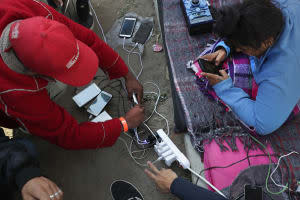The Biden administration's new facial recognition app for asylum seekers sets off alarm bells

The Biden administration recently rolled out a new app that uses facial recognition and geolocation technology to gather and store data about asylum seekers before they even enter the U.S., the Los Angeles Times reported Friday. While the Department of Homeland Security claims that the app will help alleviate some of the immense pressure at the border since the agency can't "process all individuals at once," critics have pointed out that it's alarming that the government is acquiring and saving the faceprints of "vulnerable migrants who have little choice but to consent" to using the app, as the Times writes.
"It may not seem like a big deal to match a preexisting photograph to someone standing in front of you," Sophia Cope, a senior attorney at the Electronic Frontier Foundation, explained. "But ultimately, the government is building a system of pervasive surveillance, and that creates a society that looks very different from a free republic."
The app, called CBP One, is intended to "streamline the intake of information" about migrants, cutting down on the time-consuming process of Customs and Border Protection agents manually entering information on people who arrive at the border without any travel documents. The CBP insisted to the Times that the app does not technically "store" the information either; rather, it gets sent to databases, where it is ostensibly used to verify migrants' identities.
While it's not new for the CBP to track everything from fingerprints to migrants' photographs, there have been problems with the agency's security before, like a 2018 pilot program that resulted in a facial recognition database getting hacked, compromising more than 180,000 images. ICE, of course, already uses facial recognition technology. Meanwhile, the "imposters" that the CBP app is designed to catch in the first place are, according to the Los Angeles Times, "a statistical grain of sand."
"CBP asserts migrants can still come to ports of entry directly to seek asylum and don't have to use the app," the Los Angeles Times further notes. "But with the border still closed to non-essential travel, the process by which NGOs identify asylum seekers and request permission for them to enter — now, through CBP One — is, in reality, the only option available." Read the full report here.
